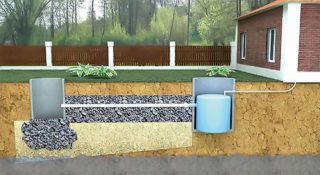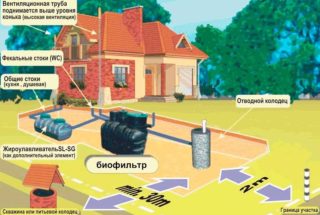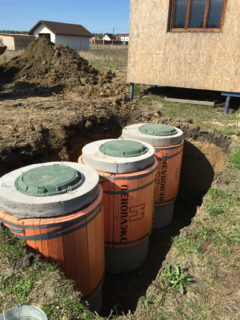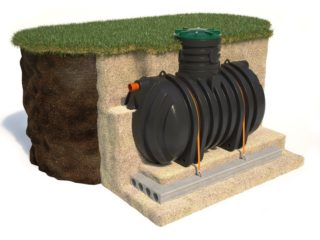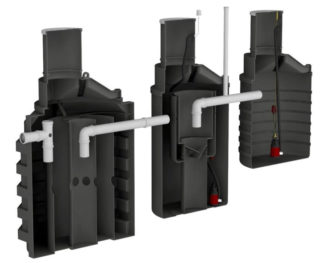Installation of the sewerage system of a country house is associated with many nuances. Having decided to install a septic tank, you need to focus on:
- Legislation;
- Features of the landscape;
- Initial data: how many people will live in the house, what volley discharges will be, how many drain points will be connected to the sewage system.
- Suitable in all respects to the type of soil;
- Satisfying all the needs of the family;
- Placed in the correct location on the lot;
- Installed in compliance with the installation technology suitable for a particular type of septic tank.
By choosing the wrong type and place for installing a septic tank, you can spoil relations with neighbors, harm the environment, and face problems with the incorrect functioning of the entire sewer system, its breakdowns.
In our country, the sphere of suburban construction is regulated by SNiP (building codes and regulations). They provide clear recommendations for the placement of sewage systems: standard distances from water protection zones, neighbors, houses, fences and roads are indicated. In case of violations of the rules given in SNiPs, you can get a large fine.
It is important to choose and install a septic tank correctly from different points of view.
The main parameters for choosing a place for a septic tank
The first thing to focus on is the type of landscape and soil. It depends on this which septic tank is suitable for each specific situation. And this will make it possible to understand how much space is needed for the selected type of septic tank, which site is suitable for its placement.
To choose the septic tank itself and the place for it, determine:
- Groundwater level;
- Soil type (sand, clay, loam, quicksand, etc.);
- How many people will use the sewer;
- What is the maximum salvo discharge (in the presence of a large bath, you need to lay a resource of 200-300 liters of water, which will be discharged at a time).
Concrete rings (septic tank)
Mixing with what will be in a septic tank made of concrete rings, complete sealing and isolation of which cannot be achieved, such groundwater will clog the entire surrounding space with harmful bacteria (Escherichia coli, etc.). This impact on the ecosystem will affect everything from contamination of the land, ending with the vegetables that you grow in the garden. This situation is especially dangerous if the water intake point feeding the house is the same concrete well, and not a well lying at a depth of several tens of meters. But even in the presence of a well, the detrimental effect on the ecology of not only your site, but also neighboring ones, will be significant. Through the concrete, dangerous bacteria will enter the soil, creating a dangerous infectious environment. Soil post-treatment of the water settled in the septic tank will be absent, which will aggravate the situation.
If the groundwater is low, a septic tank made of concrete rings will be an excellent option.But to abandon concrete rings should also be those for whom the soil is mobile. This applies to clay and quicksand. The soil can move and, acting on the concrete rings at their joints, destroy the septic tank.
After the drain, a second should be installed - a filter well. The optimal number is considered to be 3 wells. The water leaving after such purification will be further purified in the ground, which will not harm the ecology and your health.
The estimated area of the site for the installation of a septic tank with 3 wells is about 5m in length and 1.5m in width. These are approximate measurements; only a specialist can accurately determine the required area.
In the case of concrete rings, the main thing to remember is that the budget option is not always suitable. When making your own sewage system near the house, you need to approach the issue responsibly, focusing on cheapness is fraught with serious health problems that are not immediately detected.
Storage tanks
With a seasonally high groundwater table (when it rises after the snow melts), a septic tank, which is a large barrel, can be pushed out of the ground. This is the main problem with poor quality installation. In order for it not to arise, such septic tanks are "anchored": they are installed on a concrete slab, tied with chains, or they use their own backfill technology during installation (for example, sprinkling with a cement-sand mixture that hardens and forms a concrete box that holds the septic tank in the ground) ...
Another problem with septic tanks is soil crushing. It can also occur due to improper installation, when there is no protective "box" around the septic tank.
The area required for the burial of storage septic tanks depends on their volume and the type of construction chosen for soil post-treatment. If this is a filtration field, then the larger its area - the better, if the filtration well with perforated walls - less space is required, but such additional treatment will cost more. It should be borne in mind that with high groundwater, additional treatment should be above the ground surface - only a bulk filtration field is suitable, a drainage well is inappropriate.
Each manufacturer of septic tanks gives approximate calculations of the appropriate amount of sewage, based on the number of people in the family. The area that the system will occupy depends on this. You can save space by limiting the functions of the septic tank only to the accumulation of drains, which will be periodically pumped out by the sewer machine. Without drainage and purification of water, it will take up a smaller area.
The installation of storage septic tanks should be entrusted to professionals - only in this case you can be sure that there will be no problems: the septic tank will not float, squeeze, freeze, etc.
VOC (waste water treatment plants)
E
The main misconception that has spread in connection with the appearance of such sewers is that water from them can be immediately diverted into a ditch. It is enough to approach the place where such water is discharged to understand that this is just a marketing ploy, with which the sellers of such septic tanks are trying to mitigate their high cost. Moreover, this water is easy to take for analysis. The ecology suffers, since a lot of harmful substances (nitrates, E. coli, etc.) enter the open ground, poisoning everything around. Soil post-treatment is required: after VOC, water must be drained into a filter well or into a filtration field, and only then go into the ground for post-treatment.
Due to the ergonomic design, the space for aeration units is the least required. A purification station plus a filter well is the most expensive, but space-saving design, reliable and, with the right approach, efficiently cleans wastewater.
SNiPs and standards
Having chosen a suitable septic tank and having decided on the area that will be needed for it, you should study SNiPs. According to SP 42.13330.2016, standards for the removal of sewage from:
- Roads - 5 m;
- Houses - 3 m with gravity drainage and 5 m with pressure outlet;
- Streams or rivers - 10 m;
- Trees - 3 m;
- Reservoirs, lakes - 30 m;
- The source supplying water to the house is 50 m.
Correct installation of a septic tank for a country house
Having chosen a suitable septic tank, the correct post-treatment of wastewater and the correct location of the sewage system, it is better to entrust the installation to specialists. Usually, this requires special equipment, since a pit for any type of septic tank will need a deep one - it will be difficult to dig one out on your own. Correct backfilling is also important - the reliability of holding the structure in the ground, the evenness of the surface around the sewer will depend on this.
Only a professional installation with a signed contract and a guarantee for work allows you to be sure that there will be no problems with the functioning of the septic tank.

